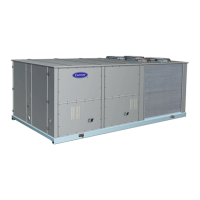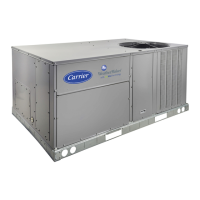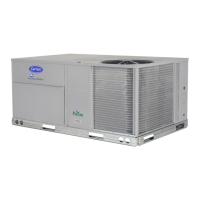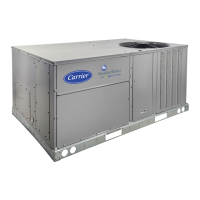34
Fig. 49 — Typical Heat Exchanger Assembly
Combustion-Air Blower
Clean periodically to assure proper airflow and heating efficiency.
Inspect the blower wheel every fall and periodically during the
heating season. For the first heating season, inspect the blower
wheel bi-monthly to determine proper cleaning frequency.
To access the burner section, open the heater access door below
the indoor fan panel.
To inspect the blower wheel, shine a flashlight into the draft hood
opening. If cleaning is required, remove the motor and wheel as
follows:
1. Remove the seven screws attaching the induced-draft motor
housing to the vestibule plate. See Fig. 49.
2. The blower wheel can be cleaned at this point. If additional
cleaning is required, continue with Steps 3 through 5.
3. Remove the blower from the motor shaft by loosening two
setscrews.
4. Remove the motor by removing the four screws that hold the
motor to the mounting plate. Remove the motor cooling fan
by removing one setscrew.
5. Remove the nuts that hold the motor to the mounting plate.
6. To reinstall, reverse the procedure outlined above.
Burners and Igniters
MAIN BURNERS
To access the burner section, open the heater access door below
the indoor fan panel. At the beginning of each heating season,
inspect for deterioration or blockage due to corrosion or other
causes. Observe the main burner flames and adjust, if neces-
sary. Flames should be conical in shape and enter the heat ex-
changer tubes with minor impingement on the sheet metal
flame components.
ORIFICE PROJECTION
Refer to Fig. 50 for maximum projection dimension for the orifice
face to manifold tube.
FLUE BAFFLE
(LOW NOX ONLY)
HEATER TUBE
ASSEMBLY
SEAL STRIPS, SPONGE RUBBER
REGULATOR
GASKET
REGULATOR
BAFFLE ASSEMBLY
(LOW NOX ONLY)
RETAINER
SUPPORT
INSULATION
ASSEMBLY
WIND CAP ASSEMBLY
(SHOWN INVERTED,
AS SHIPPED)
BURNER ASSEMBLY
INDUCER FAN-MOTOR
ASSEMBLY
CAUTION
EQUIPMENT DAMAGE HAZARD
Failure to follow this CAUTION can result in premature wear
and damage to equipment.
When working on gas train, do not hit or plug orifice spuds.

